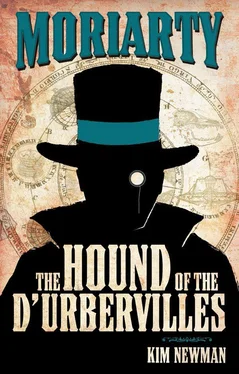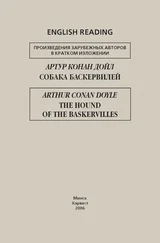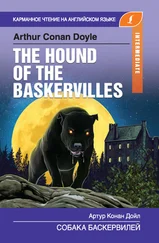Kim Newman - Professor Moriarty The Hound of the D'Urbervilles
Здесь есть возможность читать онлайн «Kim Newman - Professor Moriarty The Hound of the D'Urbervilles» весь текст электронной книги совершенно бесплатно (целиком полную версию без сокращений). В некоторых случаях можно слушать аудио, скачать через торрент в формате fb2 и присутствует краткое содержание. Жанр: Исторический детектив, на английском языке. Описание произведения, (предисловие) а так же отзывы посетителей доступны на портале библиотеки ЛибКат.
- Название:Professor Moriarty The Hound of the D'Urbervilles
- Автор:
- Жанр:
- Год:неизвестен
- ISBN:нет данных
- Рейтинг книги:5 / 5. Голосов: 1
-
Избранное:Добавить в избранное
- Отзывы:
-
Ваша оценка:
- 100
- 1
- 2
- 3
- 4
- 5
Professor Moriarty The Hound of the D'Urbervilles: краткое содержание, описание и аннотация
Предлагаем к чтению аннотацию, описание, краткое содержание или предисловие (зависит от того, что написал сам автор книги «Professor Moriarty The Hound of the D'Urbervilles»). Если вы не нашли необходимую информацию о книге — напишите в комментариях, мы постараемся отыскать её.
Professor Moriarty The Hound of the D'Urbervilles — читать онлайн бесплатно полную книгу (весь текст) целиком
Ниже представлен текст книги, разбитый по страницам. Система сохранения места последней прочитанной страницы, позволяет с удобством читать онлайн бесплатно книгу «Professor Moriarty The Hound of the D'Urbervilles», без необходимости каждый раз заново искать на чём Вы остановились. Поставьте закладку, и сможете в любой момент перейти на страницу, на которой закончили чтение.
Интервал:
Закладка:
Then there were coppers. Moriarty made sure they had no earthly notion who he might be, so they didn’t hate him quite as personally as anyone who ever met him — but they sure as spitting hated the idea of him. By now, you’ve heard the twaddle… vast spider squatting in the centre of an enormous web of vice and villainy… Napoleon of Crime… Nero of Naughtiness… Thucydides of Theft, et cetera, et cetera. Detectives of all stripe loathed the unseen King of Krooks, and blubbed to their mummies whenever they had to flounder around after one of his coups. ‘Scotland Yard Baffled,’ as if that were news. Hah!
One man above all hated Professor Moriarty. And was hated by him.
Throughout his dual career — imagine serpents representing maths and crookery, twining together like a wicked caduceus — the Prof was locked in deadly survival for supremacy — nay, for survival — with a human creature he saw as his arch-enemy, his eternal opposite, his nemesis.
Sir Nevil Airey Stent.
I don’t know how it started. Stent and Moriarty were at each other’s throats well before I became Number Two Big-ish Chief in the Firm. Whenever the Stent issue was raised, Moriarty turned purple and hissed — and was in no condition to elucidate further. I know they first met as master and pupil: Moriarty supervised young Nevil when the lad was cramming for an exam. Maybe the Prof scorned the promising mathematician’s first quadratic equation in front of the class. Maybe Stent gave him an apple with a worm in it. Upshot is: daggers drawn, eyes ablaze, lifelong enmity.
Since this record might be of some academic interest, here are a few facts and dates I’ve looked up in back editions of the Times:
1863 — Boyish twenty-three-year-old Nevil Stent, former pupil of James Moriarty, rocks the world of astronomy with his paper ‘Diffractive Properties of an Object-Glass with Circular Aperture’. Not a good title, to my mind — which runs more to the likes of
Heavy Game of the Western Himalayas
or
My Nine Nights in a Harem
(both, as it happens, written by me — good luck finding the latter: most of the run was burned by order of the crown court and the few extant volumes tend to be found in the collection of the judge who made the ruling).
1869 — Stent appointed to the Lucasian Chair of Mathematics at Cambridge University, succeeding brainboxes like Isaac Newton, Thomas Turton and Charles Babbage. Look ’em up — all gems, so I’m told. If said chair were a literal piece of furniture, it would be hand-carved by Chippendale and covered in a three-inch layer of gold flake. The Lucasian Professorship comes complete with loads of wonga, a free house, all the bowing and scraping students you can eat and high tea with the dean’s sister every Thursday. Stent barely warms the Lucasian with his bottom before skipping on to occupy an even more exalted seat, the Plumian Chair of Astronomy and Experimental Philosophy. It’s only officially a chair — everyone in Cambridge calls it the Plumian
Throne.
1872 —The book-length expansion of ‘Diffractive Properties’ lands Stent the Copley Medal of the Royal Society. This is like the VC of science. Wear that little ribbon and lesser astronomers swallow their chalk with envy when you walk by.
1873 — Stent publishes again!
On an Inequality of Long Period in the Motions of the Earth and Venus
so radically revises the Solar Tables set out a generation earlier by Jean Baptiste Joseph Delambre that the Delambre Formulae are tossed into the bin and replaced by the Stent Formulae. JB is dead or Moriarty would have had to queue up behind him for the job of Nev’s arch-enemy, methinks.
1878 — Stent knighted by Her Majesty, Queen Victoria — who couldn’t even count her own children, let alone calculate an indice of diffraction — and is therefore universally hailed the greatest astronomical mathematician of the age. Rivals choke on their abacus beads. Naturally, Sir Nevil is also appointed Astronomer Royal and allowed to play with all the toys and telescopes in the land. Gets first pick of which bits of the sky to look at. Can name any cosmic bodies he discovers after his cats. The AR position comes with Flamsteed House, an imposing official residence. Greenwich Observatory is tacked onto it, rather like a big garden shed. Lesser mortals have to throw themselves on the ground before Sir Nevil Airey Stent if they want to take so much a shufti at the man in the moon.
Cast your glims over that little lot, and consider the picture of Sir Nevil in the rotogravure. Tall, fair-haired, eyes like a romantic poet, strong arms from working an altazimuth mount, winning little-boy smile. Mrs Sir Nevil is the former Caroline Broughton-Fitzhume, second daughter of the Earl of Stoke Poges, reckoned among the beauties of the age. Tell me you don’t hate the swot right off the bat.
Now… imagine how you’d feel about Stent if you were a skull-faced, reptile-necked, balding astronomical-mathematical genius ten years older than the Golden Youth of Greenwich Observatory. Though recognised as a serious brain, that ‘European vogue’ for your ‘Treatise on the Binomial Theorem’ is but a faded memory. Your career has scarcely stretched beyond being ousted from an indifferent, non-Plumian chair — no more than a stool, they say — at a provincial university few proper dons would toss a mortarboard at. Officially, you’re an army coach — cramming sums into the heads of dimwit subalterns who need to pass exams before haring off to do daring deeds (or die of jungle fever) in far distant quarters of the Empire. No one knows about the coups and triumphs of your other business. And Stent is a hero of the world of science, a veritable comet zooming through the night sky. If you aren’t grinding your teeth with loathing, you probably lost them years ago.
Stent. It’s even a horrible name, isn’t it?
All the Dictionary of National Biography business I found out later. When Professor Moriarty, tense as a coiled cobra and twice as venomous, slithered into the reception room brandishing a copy of The Observatory — trade journal for astronomers, don’t you know — I’d have been proud to say I had never heard of the flash nob who was giving that evening’s lecture to the Royal Astronomical Society in Burlington House.
My understanding was that my flatmate and I were due to attend an exclusive sporting event in Wapping. Contestants billed as ‘Miss Lilian Russell’ and ‘Miss Ellen Terri’ in the hope punters might take them for their near look-alikes Lillian Russell and Ellen Terry were to face off, stripped to drawers and corsets, and Indian-wrestle in an arena knee-deep in custard. My ten bob was on Ellen to shove Lilian’s face into the yellow three falls out of four. I was scarcely best pleased to be informed that our seats at this cultural event would go unclaimed. We would be skulking — in disguise, yet — at the back of the room while Sir Nevil Stent delivered his latest crowd-pleasing lecture.
His title: ‘The Dynamics of an Asteroid: A Comprehensive Refutation’.
II
‘Has it not been said that The Dynamics of an Asteroid “ascends to such rarefied heights of pure mathematics there is no man in the scientific press capable of criticising it”?’
Sir Nevil Stent smiled and held up a thick volume.
I was familiar with the blasted book. At least a dozen presentation copies were stuffed into the shelves in our study. It was the Professor’s magnum opus, the sum total of his knowledge of and contribution to the Whole Art of Mathematical Astronomy. In rare moments of feeling, Moriarty was wont to claim he was prouder of these 652 pages (with no illustrations, diagrams or tables) than of the Macao-Golukhin Forgery, the Bradford Beneficent Fund Swindle or the Featherstone Tiara Theft.
Читать дальшеИнтервал:
Закладка:
Похожие книги на «Professor Moriarty The Hound of the D'Urbervilles»
Представляем Вашему вниманию похожие книги на «Professor Moriarty The Hound of the D'Urbervilles» списком для выбора. Мы отобрали схожую по названию и смыслу литературу в надежде предоставить читателям больше вариантов отыскать новые, интересные, ещё непрочитанные произведения.
Обсуждение, отзывы о книге «Professor Moriarty The Hound of the D'Urbervilles» и просто собственные мнения читателей. Оставьте ваши комментарии, напишите, что Вы думаете о произведении, его смысле или главных героях. Укажите что конкретно понравилось, а что нет, и почему Вы так считаете.


![Беар Гриллс - The Hunt [=The Devil's Sanctuary]](/books/428447/bear-grills-the-hunt-the-devil-s-sanctuary-thumb.webp)









